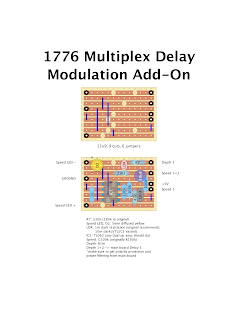Okay everyone - I've been mulling over just how I want to proceed with sharing my stripboard drawings and such since I abandoned Instagram. Which I really needed to do - the dopamine manipulating algorithms were just too damn much for my sometimes fragile mental state and I've really been doing so much better since giving Zuck the heave-ho.
I'm going to start posting here occasionally, and even though it is quite clunky to do from my phone, I think that will keep me from overdoing it - as opposed to just putting every half-baked idea that falls out of my f*cking skull up for the whole internet to see.
So this is the first thing I have decided to show off. It is based on the layout for the original Catalinbread Montavillian delay. I, like many other DIYers out here have tried A TON of PT2399 delay circuits and as endearing as the limitations of the echo chip are, I've found that most of the pedals that use it are either WAY too clean and filtered OR overburdened with that digital "puttering" that happens when you try to coax more than 500ms of delay time out of the PT2399.
The Montavillian has a quite a lot of EQ+filtering but still sounds quite close to analog/BBD. It is just dirty enough to pass for something MUCH more expensive.
I doubled the delay time of the original and, altho you can hear the repeats start to get a little ragged, there are none of the aforementioned puttering digital artifacts present.
Which is why I could add the jfet/trails switching and not worry about unwanted noise bleed. EDIT: I should have noted this on the layout, but I used a PN4393 for the switching, try a 2N5457, J201, etc. So this circuit is NOT true bypass. In addition to coloring your tone a little, the feedback/smash functions remain active at all times and will oscillate audibly when maxed, even with the circuit bypassed.
I also wired the tone pot the other way around, so that the repeats get brighter, not darker as you turn the knob clockwise. There are a few more notes on the actual picture itself about output resistor values and different ways to wire the "Smash" switch - which is an on-demand runaway feedback control.
I'm going to be posting the mod board addition that I did for this soon.





